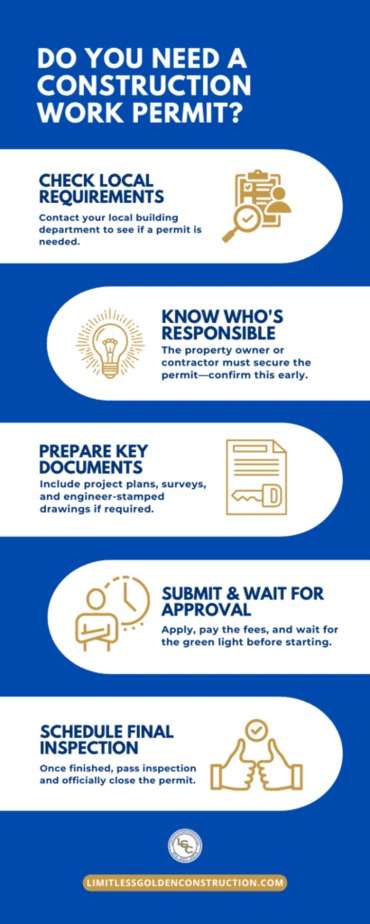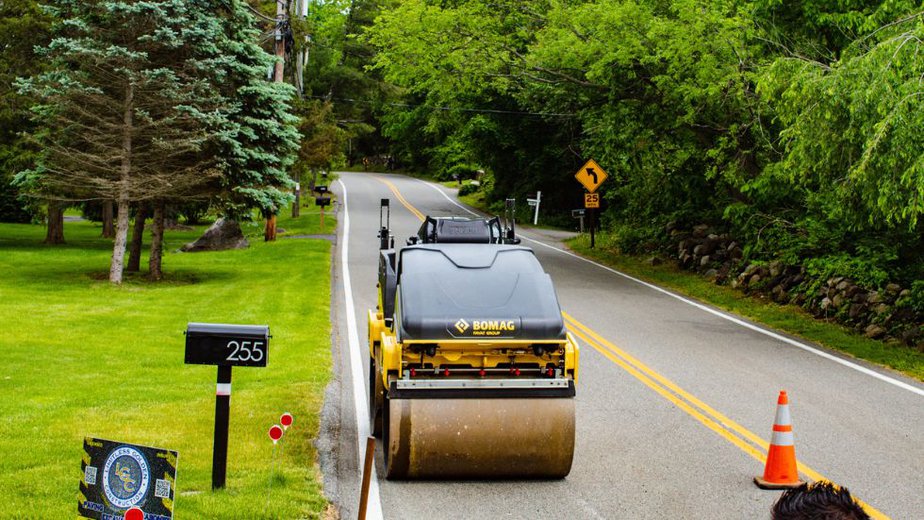Starting a construction project can be an exciting venture, but it’s important to know what legal requirements you need to meet before breaking ground. A construction work permit is often a key part of this process. But how do you determine if it’s necessary? And if it is, what steps should you take? Below, we’ll guide you through everything you need to know about work permits and what they involve.

Who Is Responsible for Construction Work Permits?
Typically, the responsibility falls on the property owner or contractor. However, this can vary depending on the project’s scope and location. Property owners are often required to ensure all necessary permits are in place. If you’re working with a contractor like Limitless Golden Construction, we’ll handle this aspect on your behalf as part of their services. However, it’s vital to clarify this upfront to avoid delays or fines.
Local municipalities or building authorities oversee permits for construction projects. Their job is to ensure that all work complies with zoning laws, safety standards, and environmental regulations. If your project involves structural changes, plumbing work, or electrical systems, there’s a good chance a permit is mandatory.
How Do You Attain a Construction Work Permit?
The process of obtaining a construction work permit can vary depending on where your project is located. However, there are some general steps most people follow:
1. Contact Your Local Building Department
Your first step is reaching out to your local building department. They’ll provide you with a list of required documents and guidelines for your specific project.
2. Submit Application and Documentation
Next, you’ll need to submit a permit application. This is usually accompanied by documents such as construction plans, project drawings, and sometimes surveys. Be prepared to explain the purpose and scope of your project.
3. Pay the Required Fees
Most permits come with an application fee. These fees can vary widely depending on the size and type of construction.
4. Wait for Approval
Once you’ve submitted everything, the building department will review your application. If approved, you’ll receive your permit, giving you the green light to start construction. If denied, they may provide feedback on how you can revise and resubmit your application.

What Else Do You Need Other Than a Construction Work Permit?
Getting a construction work permit is one step, but it’s often not the only requirement. Additional documents may be necessary to ensure your project complies with all regulations.
Engineer-Approved Drawings
For many construction projects, engineer-stamped drawings are required. These plans ensure the structural integrity and safety of your project. An engineer’s expertise is essential, especially if you’re making significant changes like adding a new room or modifying the building’s framework.
Updated Property Survey
An updated survey is another critical document. It outlines your property’s boundaries and helps verify that your construction doesn’t encroach on neighboring land. Surveys also confirm compliance with zoning regulations, such as setback requirements.
Having these documents ready can speed up the permit process and prevent misunderstandings with city inspectors or neighboring property owners.
What Happens After the Job Is Done With a Construction Work Permit?
After completing your construction project, your responsibilities don’t end with the last hammer stroke. Here’s what you need to wrap up:
Final Inspections
Most permits require final inspections from municipal officials. Inspectors will check that all work complies with the approved plans and meets safety codes. If any issues arise, you may need to make adjustments before receiving final clearance.
Closing the Construction Work Permit
Once the inspector is satisfied, your permit will be closed. This step is essential because an open permit can cause problems down the road, especially if you decide to sell the property.
Documentation for Future Use
Keep records of your closed permit and inspection approvals. These documents may be valuable if you need to show proof of compliance during a sale or refinance.

Managing Your Construction Work Permit
A construction work permit might seem like a hassle, but it ensures your project is safe, legal, and up to code. From understanding who’s responsible to gathering additional documentation like engineer drawings and surveys, each step plays a crucial role.
By following the process and staying organized, you can avoid costly delays and focus on bringing your vision to life. Whether you’re building a new structure or renovating an old one, getting your permit squared away is the first step toward success.


